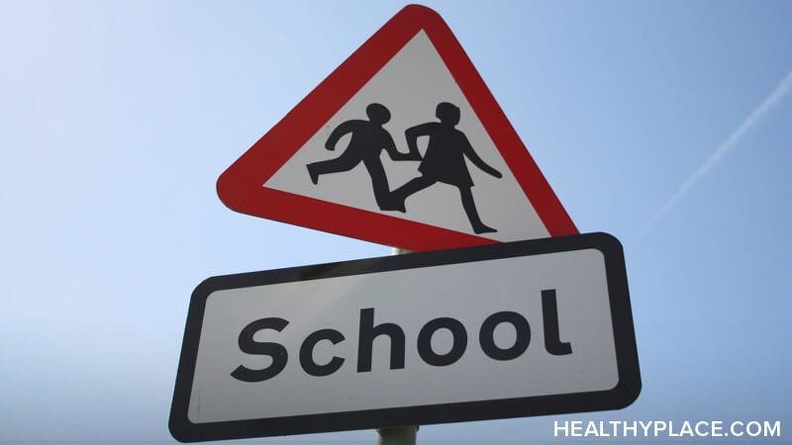Intervening in Child and Teen Suicide at School
The School's Role in Dealing with Suicide
Intervention can take many forms and should throughout the different stages in the process. Prevention includes education efforts to alert students and the community to the problem of teen suicidal behavior. Intervention with a suicidal student is aimed at protecting and helping the student who is currently in distress.
Postvention occurs after there has been a suicide in the school community. It attempts to help those affected by the recent suicide. In all cases, it is a good idea to have a clear plan in place in advance. It should involve staff members and administration. There should be clear protocols and clear lines of communication. Careful planning can make interventions more organized, and effective.
Prevention often involves education. This may be done in a health class, by the school nurse, school psychologist, guidance counselor or outside speakers. Education should address the factors that make individuals more vulnerable to suicidal thoughts. These would include depression, family stress, loss, and drug abuse. Other interventions may also be helpful. Anything that decreases drug and alcohol abuse would be useful.
A study by Rich et al found that 67% of completed youth suicides involved mixed substance abuse. PTA meetings offering family spaghetti dinners can draw in parents so that they can be educated about depression and suicidal behavior. "Turn off the TV Week" campaigns can increase family communication if the family continues with the reduced TV viewing. Parents should be educated about the risk of unsecured firearms in the home. Peer mediation and peer counseling programs can make help more accessible. However, it is critical that students go to an adult if serious behaviors or suicidal issues emerge. Outside mental health professionals can discuss their programs so that students can see that these individuals are approachable.
Intervention With a Suicidal Student
Many schools have a written protocol for dealing with a student who shows signs of suicidal or other dangerous behavior. Some schools have automatic expulsion policies for students who engage in illegal or violent behavior. It is important to remember that teens who are violent or abuse drugs may be at increased risk for suicide. If someone is expelled, the school should attempt to help the parents arrange immediate and possibly intensive psychiatric and behavioral intervention.
-
Calm the immediate crisis situation. Do not leave the suicidal student alone even for a minute. Ask whether he or she is in possession of any potentially dangerous objects or medications. If the student has dangerous items on his person, be calm and try to verbally persuade the student to give them to you. Do not engage in a physical struggle to get the items. Call administration or the designated crisis team. Escort the student away from other students to a safe place where the crisis team members can talk to him. Be sure that there is access to a telephone.
-
The crisis individuals then interview the student and determine the potential risk for suicide.
- If the student is holding on to dangerous items, it is the highest risk situation. Staff should call an ambulance and police and the student's parents. Staff should try to calm the student and ask for the dangerous items.
- If the student has no dangerous objects but appears to be an immediate suicide risk, it would be considered a high-risk situation. If the student is upset because of physical or sexual abuse, staff should notify the appropriate school personnel and contact Child Protective Services. If there is o evidence of abuse or neglect, staff should contact parents and ask them to come in to pick up their child. Staff should inform them fully about the situation and strongly encourage them to take their child to a mental health professional for an evaluation. The team should give the parents a list of telephone numbers of crisis clinics. If the school is unable to contact parents, and if Protective Services or the police cannot intervene, designated staff should take the student to a nearby emergency room.
- If the student has had suicidal thoughts but does not seem likely to hurt himself in the near future, the risk is more moderate. If abuse or neglect is involved, staff should proceed as in the high-risk process. If there is no evidence of abuse, the parents should still be called to come in. They should be encouraged to take their child for an immediate evaluation.
- Follow-Up: It is important to document all actions taken. The crisis team may meet after the incident to go over the situation. Friends of the student should be given some limited information about what has transpired. Designated staff should follow up with the student and parents to determine whether the student is receiving appropriate mental health services. Show the student that there is ongoing care and concern in the school.
Prevention of Child and Teen Suicide
An attempted or completed suicide can have a powerful effect on the staff and on the other students. There are conflicting reports on the incidence of a contagion effect creating more suicides. However, there is no doubt that individuals close to the dead student may have years of distress. One study found an increased incidence of major depression and posttraumatic stress disorder 1.5 to 3 years after the suicide. There have been clusters of suicides in adolescents. Some feel that media sensationalization or idealized obituaries of the deceased may contribute to this phenomenon.
The school should have plans in place to deal with a suicide or other major crisis in the school community. The administration or the designated individual should try to get as much information as soon as possible. He or she should meet with teachers and staff to inform them of the suicide. The teachers or other staff should inform each class of students. It is important that all of the students hear the same thing. After they have been informed, they should have the opportunity to talk about it.
Those who wish should be excused to talk to crisis counselors. The school should have extra counselors available for students and staff who need to talk. Students who appear to be the most severely affected may need parental notification and outside mental health referrals.
Rumor control is important. There should be a designated person to deal with the media. Refusing to talk to the media takes away the chance to influence what information will be in the news. One should remind the media reporters that sensational reporting has the potential for increasing a contagion effect. They should ask the media to be careful in how they report the incident.
Media should avoid repeated or sensationalistic coverage. They should not provide enough details of the suicide method to create a "how to" description. They should try not to glorify the individual or present suicidal behavior as a legitimate strategy for coping with difficult situations.
What can you do to support a student with suicidal thoughts and low self-esteem?
- Listen actively. Teach problem-solving skills.
- Encourage positive thinking. Instead of saying that he cannot do something, he should say that he will try.
- Help the student write a list of his or her good qualities.
- Give the student opportunities for success. Give as much praise as possible.
- Help the student set up a step-by-step plan to achieve his goals.
- Talk to the family so that they can understand how the student is feeling.
- He or she might benefit from assertiveness training.
- Helping others may raise one's self-esteem.
- Get the student involved in positive activities in school or in the community.
- If appropriate, involve the student's religious community.
- Make up a contract with rewards for positive and new behaviors.
This checklist is from the American Foundation for Suicide Prevention
APA Reference
Gluck, S.
(2022, January 11). Intervening in Child and Teen Suicide at School, HealthyPlace. Retrieved
on 2025, December 19 from https://www.healthyplace.com/depression/articles/intervening-in-child-and-teen-suicide




